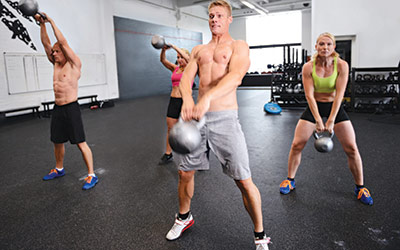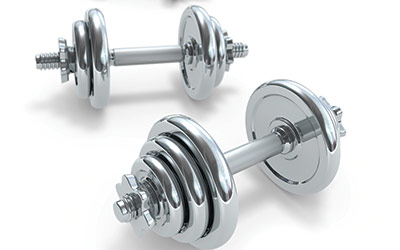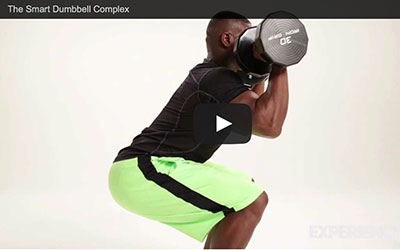Q1: How do I integrate cardio into my strength routine?
A: The easiest way to get more of a cardio challenge from your strength-training workout is to tighten up the rest time between sets so that your heart rate stays elevated.
You can do this in a number of ways:
- Try a piece of cardio equipment between exercises.
- Keep track of your rest between sets and slowly whittle it down to a half-minute or so.
- Organize your workouts into pairs of exercises and alternate sets with minimal rest between them. For instance, do a set of pushups and a set of lunges, and repeat until you’ve done three sets of each move.
The toughest version of this hybrid-style workout? “Density circuits,” says Robert dos Remedios, MS, CSCS, director of speed, strength, and conditioning at California’s College of the Canyons and author of Cardio Strength Training. Choose four or five exercises that, together, target the whole body — the kettlebell swing, overhead press, weighted alternating lunge, and assisted pull-up, for example. For each move, says Dos Remedios, select a weight you can handle for 10 to 12 repetitions, and place everything you need for all your chosen exercises in one area of the gym.
Next, start a timer and do eight reps of the first exercise. When you complete the set, move to the next exercise and wait until the timer hits the one-minute mark. Then do eight reps, and, as with the first exercise, wait until you’ve spent one minute in total at that station. Continue moving through the circuit, starting each new set at the one-minute mark, up to five times, for a total of 25 sets in about 25 minutes. On single-arm or single-leg movements, like dumbbell rows or lunges, you’ll spend more time at the station because you’re working each side, so the whole workout will take you slightly longer.
Density circuits are tough, so start out with just two or three circuits and take an extra minute or two of rest between each cycle. Over time, add cycles and lose the extra rest.
Q2: AMRAP
Q: I’d like to be able to do a specific number of reps of a certain exercise. What’s the best way to work toward that goal?
A: To hit a specific number of reps of a certain exercise — say, 10 consecutive pushups or 60 continuous body-weight squats — try incorporating as many reps as possible (AMRAP) into your routine, says Chad Waterbury, MS, author of Huge in a Hurry.
Here’s how AMRAP works: Rather than approaching an exercise with a goal number of sets and reps in mind (say, three sets of 10), you aim for a total number of repetitions (say, 30) and take as many sets as you need to accomplish them.
As the name suggests, AMRAP requires that you continue each set to the point of momentary “technical failure,” or until you can’t do another rep with good form. So choose your exercises carefully: Working to complete failure with a heavy weight on challenging exercises like deadlifts or squats, for example, can be dangerous. Body-weight moves like pushups and lunges work well with this technique.
If you’re trying to work up to 60 continuous reps of body-weight squats, for example, you might do an AMRAP sequence consisting of 20 reps on your first set, followed by a 30-second pause, then 17 reps, another rest, then 12, and so on, taking each set to failure, until you’ve done all 60 reps. Over time, you’ll reach 60 reps in a single set.
(AMRAP is also used as an acronym for as many rounds as possible, which is different. To learn about the distinction, visit ELmag.com/amraprounds.)
Q3: Fitness Certifications
Q: The trainers at my gym all seem to have different certifications: NASM, CSCS, and so on. What do they mean? Are some better than others?
A: At last count there were more than 10 organizations certifying personal trainers, all accredited by the National Commission for Certifying Agencies (NCCA), and each claiming to be the “industry standard.” Nearly all of them offer in-depth information, hands-on training, and high standards for certification; which credential to look for in a trainer depends largely on your needs. “All major certifications grew out of different aspects of the health and fitness community and, so, naturally have different strengths and specialties,” says Adam James, vice president of the National College of Exercise Professionals.
Here are a few of the more common certifications:
ACE
ACE (American Council on Exercise) certification covers the fundamentals of exercise science and is often a starting point for trainers who may go on to more specialized certifications later in their careers.
ACSM
ACSM (American College of Sports Medicine) certification was developed in the medical community, James explains, “and is regarded as the premier source of information for cardiovascular training.” Because they are less focused on resistance training, you’re unlikely to find ACSM trainers in your typical health club.
NASM
Another organization with strong ties in both the medical community and professional sports is NASM (National Academy of Sports Medicine). “Their slow-and-steady approach to training can be applied to anyone from sedentary grandmothers to high-level athletes,” says James. Life Time Academy (LTA), the fitness-professional training program offered by Life Time, partners with NASM to certify graduates. (LTA also partners with ACE to certify trainers in group fitness instruction and with Peak Pilates to certify Pilates instructors.)
CPT, CSCS
The National Strength and Conditioning Association (NSCA) has rigorous standards for its major certifications: CPT (Certified Personal Trainer), for people wishing to work with the general population, and CSCS (Certified Strength and Conditioning Specialist), for trainers wishing to focus on improving athletic performance. “The NSCA has close ties to colleges,” James says. “Their trainers are often great at working with athletes.”
Bear in mind that the letters behind a person’s name aren’t the only considerations when it comes to finding the best fit for you. A trainer’s personality and other experiences will likely affect how he or she approaches training just as much as the certification. So look beyond the letters to get a complete picture of a trainer before hiring him or her on a long-term basis.
Q4: Physio Tape
Q: I see pro athletes wearing strips of colored tape on their arms, legs, and torsos. Is it useful for everyday athletes?
A: First developed in the 1970s, physio or kinesiology tape is a therapeutic adhesive applied to the body in patterns resembling racing stripes. Research suggests that taping is effective in temporarily relieving some types of pain — particularly in the shoulders, ankles, and knees. It works best in the short term, such as when you’re playing an important league match or engaging in some other physical activity that can’t be postponed. Many experts believe the tape cues muscles to fire and connective tissue to track more efficiently, thus reducing stress on the injured area.
For longer-term pain relief, taping seems to be less effective. One 2013 study published in the European Journal of Physical and Rehabilitation Medicine found no evidence that taping has lasting effects on pain or range of motion. And on its own, says Los Angeles–area physical therapist Juliana Gildesgame, DPT, taping won’t solve dysfunctional movement long term: “Taping is a Band-Aid measure — if you don’t correct the movement strategy, you will not create sustainable pain management.” That means addressing the source of the pain, getting adequate rest, working with a qualified trainer, and, quite possibly, spending some time with a physical therapist.
If a trainer or physical therapist decides that taping is a good fit for you, he or she will apply the tape and show you how to tape yourself as well (each application lasts three to four days). Tape is available online, along with instructions on how to apply it (see Kinesio Taping Association International), but keep in mind that if you need tape, you may also need some physical therapy.
Once applied, “rub the tape to heat it up. Then recheck the motion [that’s causing pain] to see if you feel relief,” says Gildesgame. “You should feel an immediate difference and may be able to perform your other rehab exercises more effectively.”




This Post Has 0 Comments